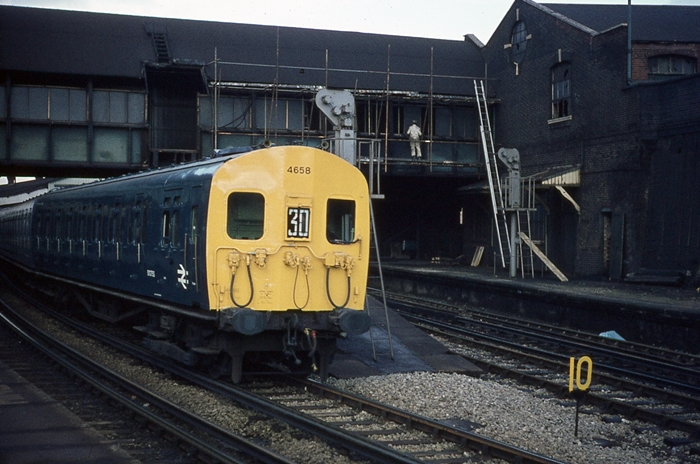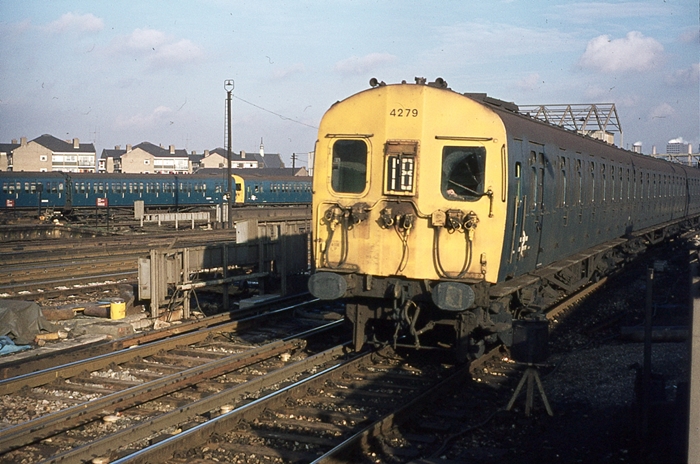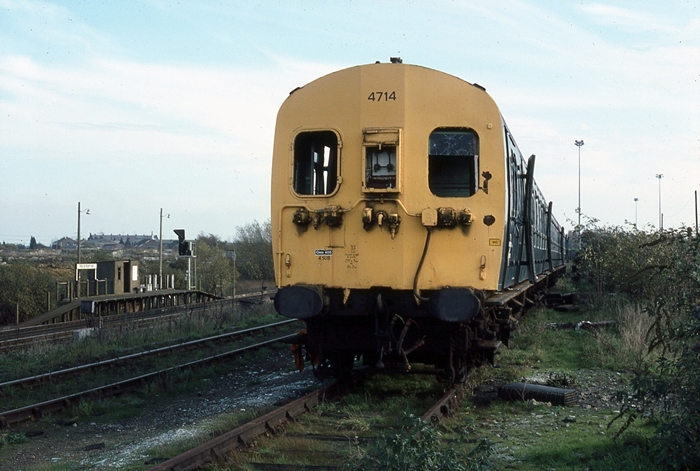
Class 405
4 SUB: Suburban
In 1946, in addition
to suburban stock reformations, the construction of new-build 4 SUB units
recommenced. These later batches differed from the 1941 prototype; firstly, the
cab was now slab-fronted, to a design similar to that later used by Bulleid on
the EPB units; secondly, the all-Standard Class seating capacity had dropped to
420. The removal of seats permitted more spacious compartments, creating more
standing room. The thinking behind this revolved around the fact that, even if
there were still seats available during the peak, commuters would still be
standing in other portions of the train. For instance, for those passengers
returning home from the capital, it would be natural to embark on the rear of
the train, simply because it is the shortest distance from the concourse.
Therefore, the back of the train becomes crowded, whilst the front remains
under-utilised. Unit Nos. 4111 to 4130 were assembled at Eastleigh during this
year, and a further thirteen units were produced in 1947 to the same design,
these being numbered in the 4364 to 4376 series. In accordance with the SR’s
long-standing and well-known practice of recycling stock, many of these
supposedly new units re-used components from withdrawn sets. Steel underframes,
originally built at the ex-LB&SCR’s Lancing Works for earlier classes, were
reused, and second-hand bogies were also incorporated into the construction
programme. Running concurrent with this new-build scheme were further extensive
unit strengthening exercises, which eventually produced no less than 204
re-numbered formations. Vehicles in these sets dated back to the pre-Grouping
era: some were ex-SE&CR or ex-LSWR steam-hauled carriages, whilst others were
formerly part of the original AC electric sets of the LB&SCR.
British Railways was formed in January 1948, but 4 SUB production at Eastleigh
continued. Twenty-three new-build units had been produced by the end of 1949,
numbered in the 4277 to 4299 series, but internally, these differed from their
earlier classmates. They featured central corridors, incorporated in response to
popular passenger demand, which created a greater amount of standing room for
the busier peak periods. 134 units of this design were produced at Eastleigh
between 1949 and 1951 inclusive, built in three batches of thirty-two,
fifty-seven, and forty-five sets respectively. 1951 marked the final year of 4
SUB production, and the type had become native to the South Eastern, South
Western, and Central Divisions of the Southern Region. Hereafter, suburban unit
construction continued in the form of the EPB units, the first of which had been
completed by the end of the same year, subsequently being deployed into
revenue-earning service in January 1952. The advent of this more recent breed of
EMU allowed the progressive withdrawal of those 4-SUB units which had been
derived from ex-three vehicle formations, particularly those constituted of
pre-Grouping carriages. Those 4 SUB units produced from 1949 onwards were
equipped with four EE507 traction motors rated at 250 HP each. The EE507 was
English Electric’s standard traction motor, and this model continued to be used
by the Southern Region during the EPB suburban unit production.
Withdrawal of new-build production line stock did not commence until 1972, the
first casualties in the October being the dome-shaped cab examples built to the
1941 design. The culling of the fleet was undertaken over an eleven year period;
the final units to go were those on the Central Division in September 1983, the
last of the type operating in revenue-earning service on 6th of that month.
These units were wired for 660 Volt DC operation, which meant that only after
their total withdrawal could further parts of the SR suburban network be
upgraded to a current of 750 Volts. Continuing the SR tradition of recycling, a
number of 4 SUB trailers from the final builds of the 1946 design were retained.
Subsequently, these were restored and inserted into refurbished 4 EPB units.
Storage locations of units awaiting scrapping
Crystal Palace
Hither Green Marshalling Yard
Hoo Junction
Lancing
Micheldever
Norwood Yard
Plumstead Sidings
Selhurst
One 4 SUB unit, No. 4732, was retained by British Rail, and subsequently returned to Southern Railway livery (although with front yellow warning panel). This 4 SUB had survived for the sole purpose of operating with preserved 2 BIL No. 2090 on the British Rail network; the latter no longer had a safety case to operate on its own.
Late 1970s

A shiny No. 4658 is seen departing Clapham Junction with a Victoria to Gatwick Airport service. © David Glasspool Collection
Late 1970s

4 SUB galore at Clapham Junction: No. 4279 is seen approaching with an ex-Waterloo to Chessington South service, whilst in the background can be seen further 4 SUB stock on the ''Windsor'' lines. © David Glasspool Collection
1st June 1984

Many of the 4 SUB units were stored and subsequently scrapped at Hoo Junction by Smeeth Metals. We see No. 4714 at the western end of Hoo Junction ''up'' yard - the open doors give a good indication of the unit's curvature. In the background, to the left, is the diminutive ''down'' platform of Hoo Junction Staff Halt, which was brought into use during 1956. © David Glasspool Collection
Return to the Kent Rail Homepage or alternatively, check for Updates.
Website & Copyright information - Links - Contact the Webmaster
All content is copyright © David Glasspool unless otherwise stated